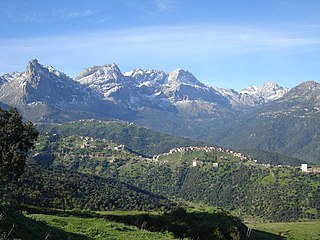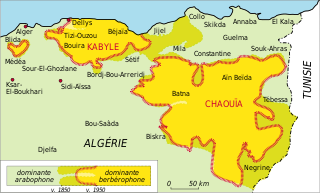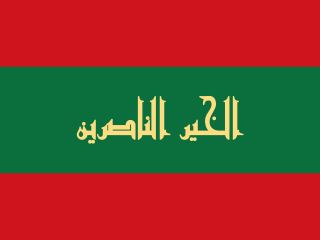
Berbers or the Berber peoples, also called by their endonym Amazigh or Imazighen, are a diverse grouping of distinct ethnic groups indigenous to North Africa who predate the arrival of Arabs in the Arab migrations to the Maghreb. Their main connections are identified by their usage of Berber languages, most of them mutually unintelligible, which are part of the Afroasiatic language family. They are indigenous to the Maghreb region of North Africa, where they live in scattered communities across parts of Morocco, Algeria, Libya, and to a lesser extent Tunisia, Mauritania, northern Mali and northern Niger. Smaller Berber communities are also found in Burkina Faso and Egypt's Siwa Oasis.

Kabylia or Kabylie is a mountainous coastal region in northern Algeria and the homeland of the Kabyle people. It is part of the Tell Atlas mountain range and is located at the edge of the Mediterranean Sea.

The Chaoui people or Shawia are a Berber ethnic group native to the Aurès region in northeastern Algeria which spans Batna and Khenchla, Oum El Bouaghi provinces located in and surrounded by the Aurès Mountains.

The Kabyle people are a Berber ethnic group indigenous to Kabylia in the north of Algeria, spread across the Atlas Mountains, 160 kilometres (100 mi) east of Algiers. They represent the largest Berber population of Algeria and the second largest in North Africa.

Sheikh Mohamed El-Mokrani, also known as Mohand Amokrane, was one of the principal leaders and the namesake of the Mokrani Revolt of 1871 against the French occupation of Algeria.

The Capture of Béjaïa or Capture of Bougie occurred in 1555 when Salah Rais, the Ottoman ruler of Algiers, took the city of Béjaïa from the Spaniards. The main fortification in Béjaïa was the Spanish presidio, occupied by about 100 men under first under Luis Peralta, and then his son Alonso Peralta. The city was captured by Salah Rais from his base of Algiers, at the head of several thousand men and a small fleet consisting in two galleys, a barque, and a French saëte requisitioned in Algiers. Peralta had sent messages to Spain for help, and Andrea Doria prepared to leave with a fleet from Naples, but it was too late.

The capture of Algiers in 1516 was accomplished by the brothers Oruç and Hayreddin Barbarossa against Sālim al-Tūmī, the ruler of the city of Algiers, which was followed by an unsuccessful military campaign by the Spanish Empire and the Sheikh of Ténès to overthrow the newly formed Sultanate of Algiers.

Igawawen or Gawawa, mostly known as Zwawa were a group of Kabyle tribes inhabiting the Djurdjura mountains, Greater Kabylia, in Algeria. The Zouaoua are a branch of the Kutama tribe of the Baranis Berbers.

Ali V Ben Ahmed, nicknamed Ali Khodja, Ali-Meguer, or Ali Loco was a Kouloughli of partial Georgian (Mengrelian) and Native Algerian origins born in Algeria. He was the dey of the Deylik of Algiers from September 1817, just after the assassination of his predecessor Omar Agha the 8th. He remained so until his death in February 1818. His sobriquet Ali-Meguer may indicate his Mingrelian background.

The Kingdom of the Ait Abbas or Sultanate of the Beni Abbas was a Kabyle, Berber state of North Africa, then a fief and a principality, controlling Lesser Kabylie and its surroundings from the sixteenth century to the nineteenth century. It is referred to in the Spanish historiography as "reino de Labes"; sometimes more commonly referred to by its ruling family, the Mokrani, in Berber At Muqran. Its capital was the Kalâa of Ait Abbas, an impregnable citadel in the Biban mountain range.

Conflicts between the Regency of Algiers and the Cherifian dynasties or Algerian-Sherifian conflicts opposed Morocco to the Ottoman Empire and its dependencies in a series of wars between the Regency of Algiers and its allied local sultanates and tribal confederations, and on the other hand, the Sharifian Saadian and Alawite dynasties that had ruled Morocco since the 16th century.

The Tuggurt expedition in 1552 aimed to obtain the submission of the Saharan cities of Tuggurt and Ouargla, seats of independent sultanates. Salah Rais, beylerbey of the Regency of Algiers, was allied to the troops of the Kingdom of Ait Abbas, led by their sultan, Abdelaziz al-Abbas.

The Mokrani Revolt was the most important local uprising against France in Algeria since the conquest in 1830.
The Campaign of Tlemcen or Tlemcen campaign was a military operation led by the Saadians of Mohammed ash-Sheikh against Tlemcen in 1557, then under the domination of the Regency of Algiers, a vassal state of the Ottoman Empire. Mohammed ash-Sheikh, who wanted to conquer Algeria, occupied the city but failed to seize the Mechouar Palace, which was defended by a garrison of 500 men under the command of Caïd Saffa.

The Campaign of Tlemcen (1551) was a military operation led by the Regency of Algiers under Hasan Pasha and his ally Abdelaziz, following the capture of Tlemcen by the Saadi Sultanate in June 1550.

The capture of Béjaïa was the battle in which the Spanish Empire took possession of Béjaïa, then an emirate ruled by a branch of the Hafsid dynasty. This took place in 1510. The Spanish lost the city again 45 years later to Salah Rais and the Kingdom of Kuku in the Capture of Bougie (1555).

The Capture of Tunis in 1569 was a campaign led by Uluç Ali to conquer Tunis.
The Battle of Oued-el-Lhâm was a battle between the Regency of Algiers and the Kingdom of Beni Abbas that took place one year after the Battle of Kalaa which led to this attempt for revenge by the Regency.
Ahmed ou el Kadhi was a Kabyle sultan and the founder of the Kingdom of Kuku in 1515.














